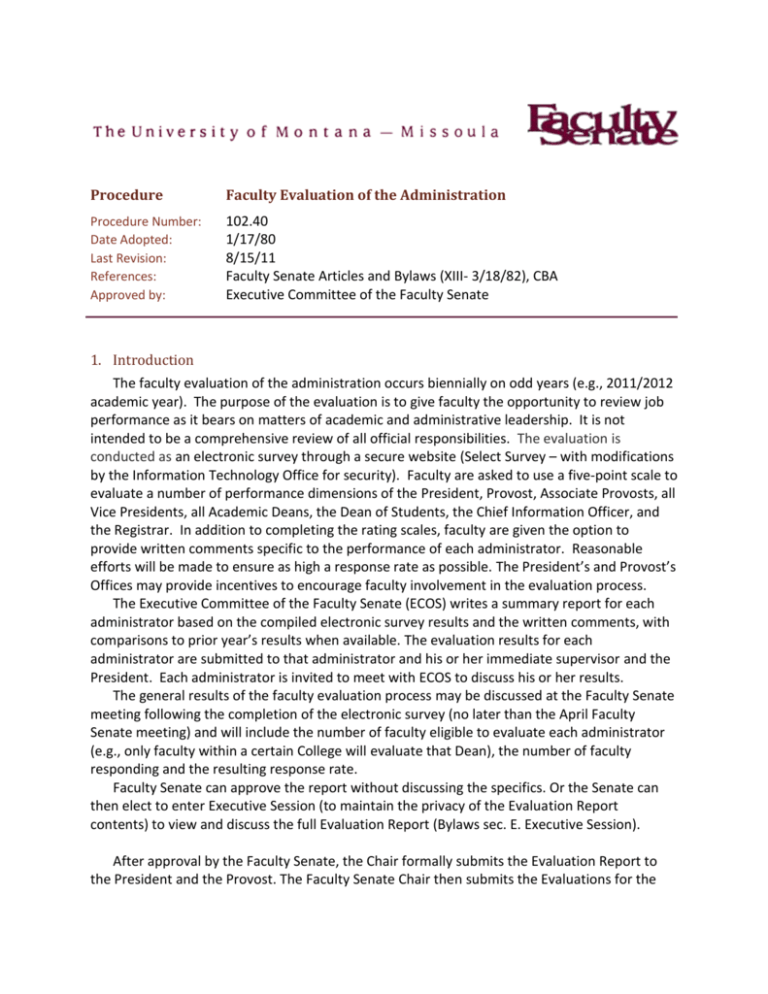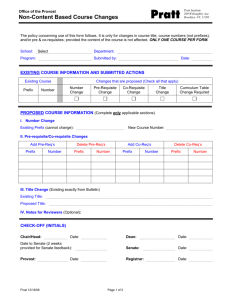102.40 Evaluation of the Administration
advertisement

Procedure Faculty Evaluation of the Administration Procedure Number: Date Adopted: Last Revision: References: Approved by: 102.40 1/17/80 8/15/11 Faculty Senate Articles and Bylaws (XIII- 3/18/82), CBA Executive Committee of the Faculty Senate 1. Introduction The faculty evaluation of the administration occurs biennially on odd years (e.g., 2011/2012 academic year). The purpose of the evaluation is to give faculty the opportunity to review job performance as it bears on matters of academic and administrative leadership. It is not intended to be a comprehensive review of all official responsibilities. The evaluation is conducted as an electronic survey through a secure website (Select Survey – with modifications by the Information Technology Office for security). Faculty are asked to use a five-point scale to evaluate a number of performance dimensions of the President, Provost, Associate Provosts, all Vice Presidents, all Academic Deans, the Dean of Students, the Chief Information Officer, and the Registrar. In addition to completing the rating scales, faculty are given the option to provide written comments specific to the performance of each administrator. Reasonable efforts will be made to ensure as high a response rate as possible. The President’s and Provost’s Offices may provide incentives to encourage faculty involvement in the evaluation process. The Executive Committee of the Faculty Senate (ECOS) writes a summary report for each administrator based on the compiled electronic survey results and the written comments, with comparisons to prior year’s results when available. The evaluation results for each administrator are submitted to that administrator and his or her immediate supervisor and the President. Each administrator is invited to meet with ECOS to discuss his or her results. The general results of the faculty evaluation process may be discussed at the Faculty Senate meeting following the completion of the electronic survey (no later than the April Faculty Senate meeting) and will include the number of faculty eligible to evaluate each administrator (e.g., only faculty within a certain College will evaluate that Dean), the number of faculty responding and the resulting response rate. Faculty Senate can approve the report without discussing the specifics. Or the Senate can then elect to enter Executive Session (to maintain the privacy of the Evaluation Report contents) to view and discuss the full Evaluation Report (Bylaws sec. E. Executive Session). After approval by the Faculty Senate, the Chair formally submits the Evaluation Report to the President and the Provost. The Faculty Senate Chair then submits the Evaluations for the President, Provost, and Vice-Presidents to the Board of Regents and Commissioner of Higher Education at the May Board of Regents meeting. Method A. Identification of Eligible Faculty The Faculty Senate Office obtains a report of current faculty (as defined by Articles of the Faculty Senate [Article 1, Sec 1.] and the current CBA) from the Office of Planning, Budgeting and Analysis. The list is reviewed by the Faculty Senate administrative associate and ECOS. Retired faculty and faculty with FTE below .5 are removed from the list. The final list of eligible faculty is organized by academic unit (College and/or School) to enable the calculation of the appropriate response rate for each Academic Dean. A formal mechanism is in place to guarantee the confidentiality of faculty input. Each faculty member is assigned a unique identifying number to facilitate survey administration. Once a completed survey is collected from an eligible faculty member, the responses are separated from the unique identifying number to maintain faculty anonymity. B. Survey Questions The Administration provides a position description that includes specific goals and assessment criteria for each administrator to be evaluated. ECOS drafts a set of questions for each administrator based on prior years’ surveys and any changes identified with the position description or assessment criteria for each administrator. Administrators are given a copy of the evaluation questions, their position description, and the draft communication to faculty and are encouraged to notify the Faculty Senate Office of any revisions to their position description or survey questions as appropriate. Early in the fall semester, the Senate leadership will meet with the two Administration committees (Academic Officers and Cabinet) to discuss the evaluation process, the types of questions that will be used and to receive any feedback from the Administration. The effectiveness of the President, Provost, Vice Presidents, Associate Provosts, and the Registrar are evaluated on several common dimensions (communication, ethics, and overall effectiveness in their respective positions). In addition, each of the administrators is evaluated on other dimensions specific to their respective positions, such as academic leadership, administrative leadership, finance, curriculum, diversity, and supervised services. There is a specific question or questions under each dimension. Faculty members also evaluate their own dean for the dean’s academic leadership, , administrative leadership, communication, ethics, and overall effectiveness. C. Survey Administration To ensure the highest possible response rate, the President and the Provost may provide incentives to the faculty for completing the survey. For example, faculty completing the survey may be entered into a drawing. The President, the Provost, and the Faculty Senate Chair send a joint message to eligible faculty stressing the importance participation in the electronic survey. A separate email communication is sent with instructions to complete the evaluation by the deadline. The instructions include a link to the secure site and provide an ID number and password. The electronic survey includes links to the administrators’ current position descriptions and specific goals and assessment criteria if available. Two weeks after the initial communication is sent, an urgent follow-up message is sent to faculty who have not yet participated. A third reminder message is sent one week later. 2. Data Compilation and Reporting A. Reporting Survey results are summarized for each administrator evaluated and include the written comments and comparative data from previous years when available. The summary provides a snapshot of the evaluation data. For each item, there are several lines describing the summarized data. The first line lists the frequency of responses for each of the five points on the scale, followed by the total number of responses and the mean. The second line lists these frequencies in terms of percentages. The third line lists the percentages and the mean rating obtained in the prior survey (if available). ECOS prepares an evaluation summary for each administrator based on the summarized data and the written comments. Comparisons with previous evaluations will provide guidance as to trends in the faculty’s perception of administrator’s performance. The evaluation is intended to be a review of job performance as it bears on matters of academic and administrative leadership based on faculty perception. It is not intended to be a comprehensive review of all official responsibilities. B. Evaluation Feedback ECOS first discusses the evaluations directly with those being evaluated. The written review provided to the academic administrator shall address the evaluations received from faculty, and issues raised shall be addressed with the specific administrator under review. 3. Approval by Faculty Senate At the completion of the Evaluation Report and after meeting with the administration (President, Provost, and any administrator requesting a meeting with ECOS) the Faculty Senate will be given the option to discuss the results of the Faculty Evaluation of the Administration. To ensure the privacy of those being evaluated, the Faculty Senate votes to move into Executive Session (see Bylaws sec. E. Executive Session) and the results of the report will be discussed. The Faculty Senate than approves the Evaluation Report. 4. Disseminating the Faculty Evaluation of the Administration After approval by the Faculty Senate, the Chair formally submits the Evaluation Report to the President and the Provost. The Chair then submits the Evaluations for the President, Provost, and Vice-Presidents to the Board of Regents and Commissioner of Higher Education at the May Board of Regents meeting with a cover letter stating the purpose and method of the faculty's evaluation and the limitations of those methods. 5. Feedback on the Review Process with the President and Provost ECOS meets with the Provost to review the results of the faculty evaluation of the Academic Deans and other Academic Officers. The Provost provides ECOS with an update of issues identified in the review. ECOS meets with the President to review the results of the faculty evaluation of the VicePresidents. The President provides ECOS with an update of issues identified in the review. 6. Timeline (begins on odd numbered academic year) 1. Review and approval of eligible faculty list (Fall) 2. Development of questions (Fall) 3. Meet with Administrators (Fall) 4. Letter to faculty (Fall) 5. Follow-up to faculty not responding (Data collected by Dec) 6. ECOS writes reports and distributes to administrators and their supervisors(Jan-Feb) 7. ECOS gives each administrator the opportunity to discuss the evaluation report (Mar) 8. Faculty Senate approves report (April Faculty Senate meeting) 9. Senate Chair submits final Evaluation Report to President and Provost (April) 10. Senate Chair submits Evaluation Report to Commissioner and the Chair of Regents (May BOR meeting) 11. ECOS meets with the President and Provost for a feedback and utilization report (before June 1)









